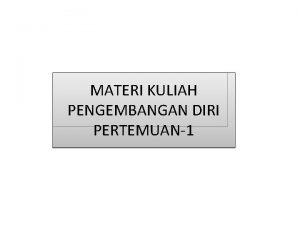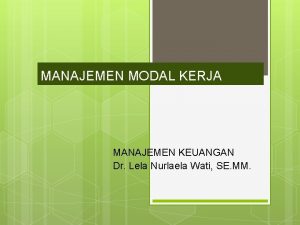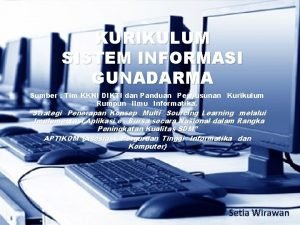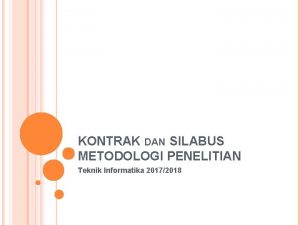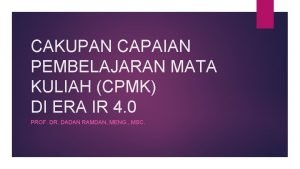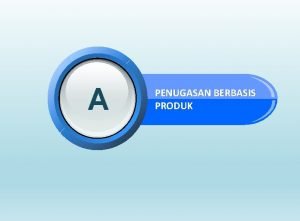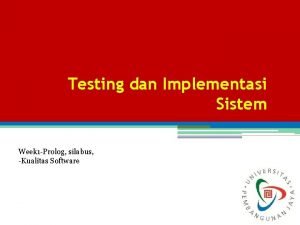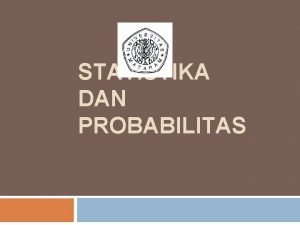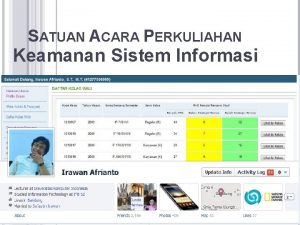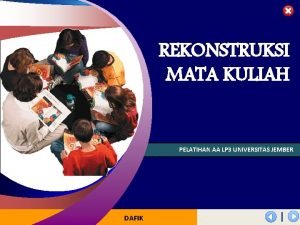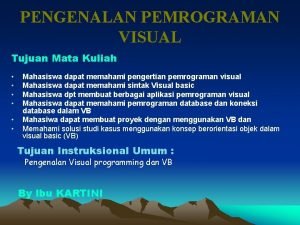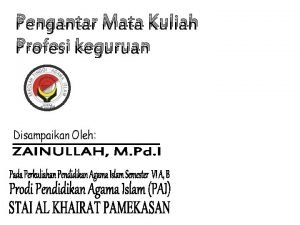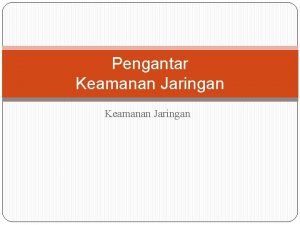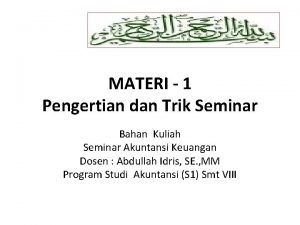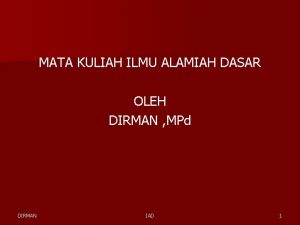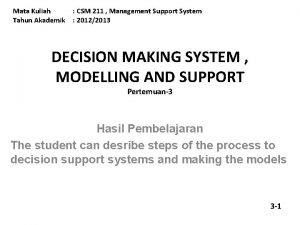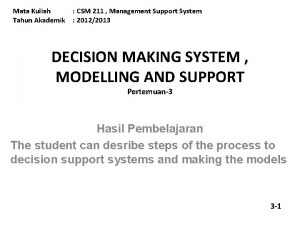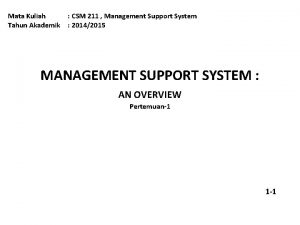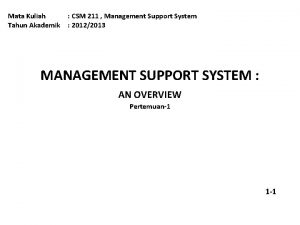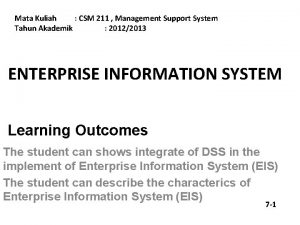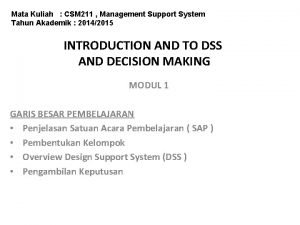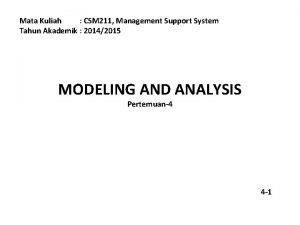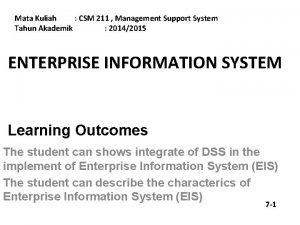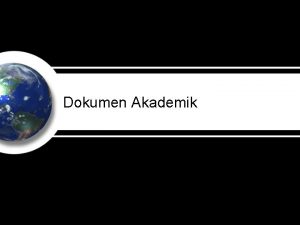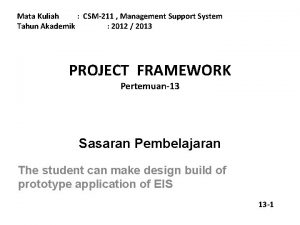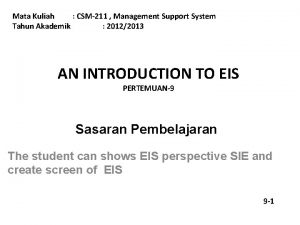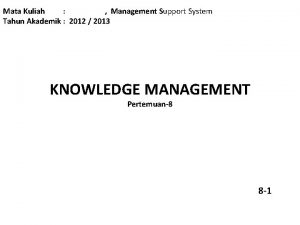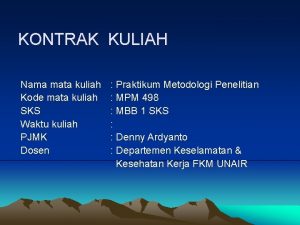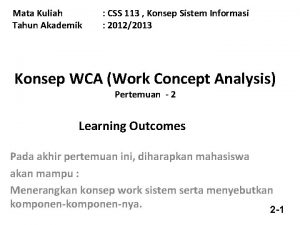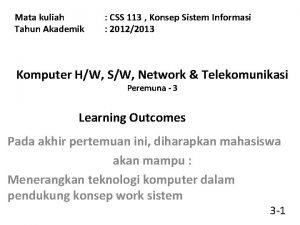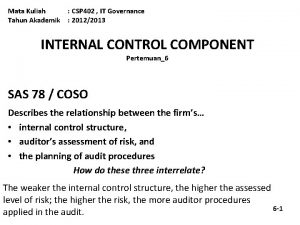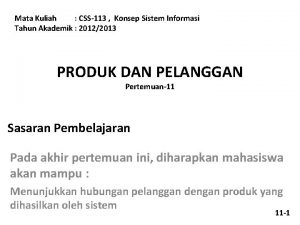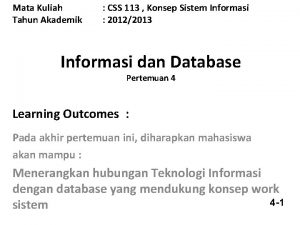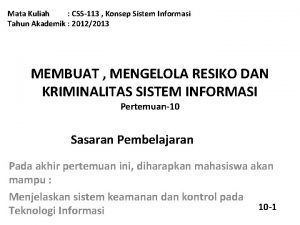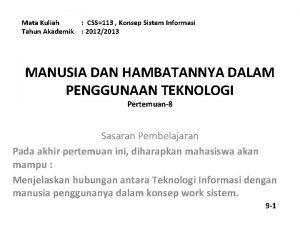Mata Kuliah Tahun Akademik CSM 211 Management Support



























- Slides: 27

Mata Kuliah Tahun Akademik : CSM 211 , Management Support System : 2012/2013 KARAKTERISTIK DAN KEMAMPUAN DECISION SUPPORT SYSTEM Pertemuan-2 Target Pembelajaran : The student can shows the process DSS, DSS Characterics, and DSS Component 2 -1

Sasaran Pembelajaran : • • Understand possible DSS Configurations Describe DSS Characteristics and capabilites Understand DSS components and how they integrate Describe the components and structure of each DSS component : the data management sub-system, the model management subsystem, the user interface (dialog) subsystem, the knowledge based managemetn subsystem, and the user Explain how the world wide web has affected DSS, and vice versa Explain the unique role of the user id DSS versus MIS Describe the DSS hardware platforms Understand the important DSS classifications 2 -2

CASE STUDY: Southwest Airlines Flies in the Face of Competition Through DSS The shows advantage DSS (Business Intelligence ) in the organizations : – Support goals objective (individual / team work) – Repetition by consistency – The primary component ( data, model and user interface) – The use subjectivity, User and data – Help decision support effectly, accurate and the best solution 2 -3

QUESTION : a. What kinds of models do you suppose southwest airlines used in its OLAP b. How can business intelligence like that utilized by southwest airlines lead to higher profit and more competitive position in the marketplace c. Explain how the benefits were obtained d. Explain how these ideas could be used in other industry segments 2 -4

DSS DEFINITIONS : • DSS as a model based set of procedures for processing data and judgments to assist a manager in his decision making • DSS is usually built to support the solution of a certain problem or to evaluation an opportunity • Focus DSS is not “What result” but “as the Input” for interactive between user and the system 2 -5

DSS APPLICATION : • DSS is an approach (methodology) for supporting decision making. It uses an interactive, flexible, adaptable Computer Based Information System (CBIS) especially developed for supporting the solution to a specific nonstructured management problem • DSS usually uses models and is built (often by end users) by an interactive and iterative process. It supports all phases of decision making and may include a knowledge component • DSS can be used by a single use on a PC or can be web based for use by many people at serveral locations 2 -6

DSS Characteristics and Capabilites 1. Support for decision makers 2. Support for all managerial levels, ranging from top executives to line managers 3. Support for individuals as well as to groups 4. Support for interdependent and sequential decisions 5. Support in all phase of the decision making process : intelligence, design, choice, and implementation 6. Support in a variety of decision making processes and styles 7. Adaptivity over time 8. User feeling of at homeness 2 -7

DSS Characteristics and Capabilites 9 Improvement of the effectiveness of decision making (accuracy, timeliness, quality) rather than its efficiency (the cost of making decisions) 10 Complete control by the decision maker over all steps of the decision making process in solving a problem 11 End users are able to develop and modify simple systems by themselves 12 Models are generally utilized to analyze decision making situations 13 Access is provided to a variety of data sources, format and types, ranging from Geographic IS to Object oriented ones 2 -8 14 Can be employed as a standalone tool used by an individual decision maker in one location or distributed.

KEY CHARACTERICS AND CAPABILITES OF DSS 2 -9

Components of DSS 1) 2) 3) 4) Data Management Subyistem (DMS) Model Management Subsystem (MMS) User Interface Subsystem (UIS) Knowledge Based Management Subsystem (KBMS) 2 -10

Data Management Subsystem (DMS) • Includes Database that contains relevant data for the situations • Interconnected with the corperate Data Warehouse Classification : • Database • DBMS • Data Directory • Query Facility 2 -11

DATABASE ü ü ü Component data organizationed and can use to other user of all application programs Database from data warehouse or create by special Data in Database extraction from data internal dan external Data internal from Transaction processing system (TPS) Data external from the Industries 2 -12

Database Management System (DBMS ) • • • Create, access, update data Extraction data from database update Relation data from different resource The shows information by use SQL Data security The process data by complex variation Search data by DSS The process data by data dictionary Data Directory Query Facility 2 -13

• Data Directory Catalog from other data in database that consist definition, function, concept of data with extraction • Query Facility Access, process data by Query 2 -14

Model Management Subsystem (MMS) • Software package that include financial, statistical, management science, or other quantitative models • Modelling langeuages for building custom models that usually called Model Based Management System(MBMS) • Component can be connected to corporate or external storage of models The classification : • Model Base • MBMS • Model Directory • Model execution 2 -15

User Interface Subsystem (UIS) • • • The user can communicates with and command the DSS through this subsystem The user is considered part of the system Researchers assert that some of the unique contributions of DSS are derived form the intensive interaction betwen the computer and the decision maker 2 -16

User Interface System Data management and DBMS Knowledge-based system Model management and MBMS User Interface Management System (UIMS) Natural Language Processor Input Action Languages Output Display Language Users PC Display Printers, Plotters 2 -17

Knowledge Based Management Subsistem (KBMS) • • • Subsystem can support any of the other subsystem or acr as an independent component Can be interconnected with the organizations knowledge repository (parth of knowledge management system) which called organizational knowledge base DSS must include major componenst of DBMS, MBMS, User interface. The KBMS is optional, but can provide many benefits by providing intelligence 2 -18

Model Schematic of DSS 2 -19

The Structure of The Data Management Subsytem 2 -20

Model Manajemen Subsistem (MMS) MODEL BASE ü Routine data and special (statistics, financial, forecast, science management) ü DSS can choice, process, change other models ü The classification : v Strategic Mmodel : support senior manager to strategic planning v Tactical Model : alocated and control resources v Operational Model : activity daily v Analytical Model : analysis data 2 -21

Model Manajemen Subsistem (MMS) MBMS : ü Function : create model with use program languange DSS Tools and Building Block, update, management data models Model Directory : ü Catalog model Model execution : ü ü ü Control Process of implement models Control integrate to combinate model operation Command, receipt and interpretation of instructions based on input from U component 2 -22

Knowledge-Based Management System ( KBMS ) • • Component personal knowledge Problem solving complex Increasing quality other component (DMS, UI, MMS) Other modul systems Tasks oriented Development, Use and process models One and more intelligence component DSS by KBMS called Inteligent DSS 2 -23

Hardware DSS • Defacto standard • Web server with DBMS: – Operates using browser – Data stored in variety of databases – Can be mainframe, server, workstation, or PC – Any network type – Access for mobile devices 2 -24

Clasification DSS Based on impact from output DSS, The categories DSS : 1. File Drawer System 2. Data Analysis System 3. Analysis Information System 4. Accounting Model 5. Representational Model 6. Optimization Model 7. Suggestion Model 2 -25

Clasification DSS The Categories DSS (Holsapple & Whinston) : 1. Text Oriented 2. Database oriented 3. Spreadsheet Oriented 4. Solver Oriented 5. Rule Oriented 6. Compound DSS (Inteligent DSS) 2 -26

Clasification DSS 1. 2. 3. 4. Institutional and Ad Hoc Personal/group/Organizational Support Individual versus Group Support (GSS) Custom Made versi Ready Made ===== thanks 4 ypur attention ===== 2 -27
 Etika profesi mahasiswa
Etika profesi mahasiswa Materi kuliah pengembangan diri
Materi kuliah pengembangan diri Erd mahasiswa
Erd mahasiswa Matkul ekonomi pembangunan ub
Matkul ekonomi pembangunan ub Mata kuliah pelayanan prima
Mata kuliah pelayanan prima Contoh soal modal kerja mata kuliah manajemen keuangan
Contoh soal modal kerja mata kuliah manajemen keuangan Kurikulum informatika gunadarma
Kurikulum informatika gunadarma Silabus metode penelitian
Silabus metode penelitian Mata kuliah ilmu kelautan unpad
Mata kuliah ilmu kelautan unpad Deskripsi mata kuliah ekonomi mikro
Deskripsi mata kuliah ekonomi mikro Tujuan creative writing
Tujuan creative writing Contoh cpmk mata kuliah
Contoh cpmk mata kuliah Cjr mata kuliah kewirausahaan
Cjr mata kuliah kewirausahaan Mata kuliah testing dan implementasi sistem
Mata kuliah testing dan implementasi sistem Mata kuliah statistika dan probabilitas
Mata kuliah statistika dan probabilitas Deskripsi mata kuliah sejarah pendidikan islam
Deskripsi mata kuliah sejarah pendidikan islam Mata kuliah keamanan sistem informasi
Mata kuliah keamanan sistem informasi Tahapan kuliah
Tahapan kuliah Matkul ekonomi islam ub
Matkul ekonomi islam ub Tujuan pemrograman visual
Tujuan pemrograman visual Mata kuliah profesi keguruan
Mata kuliah profesi keguruan Materi tentang keamanan jaringan
Materi tentang keamanan jaringan Bahan ajar mata kuliah seminar
Bahan ajar mata kuliah seminar Mata kuliah penyuntingan
Mata kuliah penyuntingan Kurikulum institusional adalah
Kurikulum institusional adalah Mata kuliah ilmu alamiah dasar
Mata kuliah ilmu alamiah dasar Materi kuliah fisika lingkungan
Materi kuliah fisika lingkungan Pengantar aplikasi komputer (spss)
Pengantar aplikasi komputer (spss)

